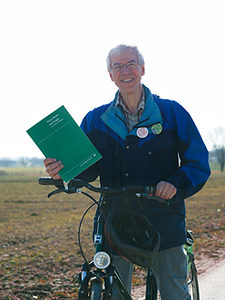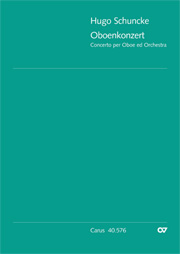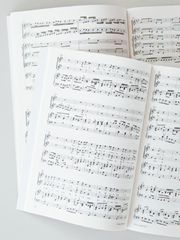A Rarity of Romantic
When people hear or read the name “Carus”, it is probably choral music which first comes to mind – sacred or secular. Then perhaps organ music, or even the LIEDERPROJEKT. But not many people would suspect that the catalog includes a truly great Romantic instrumental concerto…
When people hear or read the name “Carus”, it is probably choral music which first comes to mind – sacred or secular. Then perhaps organ music, or even the astonishingly well-received Liederprojekt. But not many people would suspect that the catalog includes a truly great Romantic instrumental concerto. This is a rarity in another respect: it is one of very few 19th century concertos for oboe and orchestra. And the composer’s name? Let’s be honest – who has heard of Hugo Schuncke? It turns out that after the Bach family, the Schuncke family, who also came from Thuringia, probably displayed the most musical talent. Over four generations in the 18th and 19th centuries the family produced over 20 professional musicians, particularly horn players; the best-known of these was Ludwig Schuncke who was highly regarded by Clara and Robert Schumann. Ludwig’s brother was Hugo Schuncke (1823–1909), who was born and trained in Stuttgart where he performed solo for the first time as a violinist at the age of 13 (!) with the orchestra of the royal court ensemble. He was a member of this ensemble for a total of 54 years as a violinist, mainly under the baton of Josef Peter von Lindpaintner. There he received much inspiration from the music and musicians around him.
Schuncke also showed an astonishing gift (“an eminent musical talent”, noted in a contemporary music encyclopaedia) as a composer, particularly impressive in his Oboe Concerto in A minor, premiered in 1846, later lightly revised. In formal layout it follows tradition, although the three movements contain some Romantic originality; the lyrical middle movement, with a wonderfully cantabile soaring theme, is followed by a spirited finale with the title “Rondo a la Bolero” in the rhythm of this Spanish dance, which Schuncke had probably encountered in the opera orchestra (and which Weber also used in “Preziosa” and “Freischütz”). A first-rate performance by the Stuttgart Schools Symphony Orchestra in autumn 2016 demonstrated that the concerto (perhaps with a professional soloist) can be successfully mastered by an amateur orchestra, and can feature as an attractive instrumental middle piece between two oratorio-type works, if an orchestra is available …
This outstanding edition of this “fine, dignifed work” by Hugo Schuncke (according to a review of 1863) is complemented by one of his vocal works in the Carus catalog – an expressive “Vater unser” (1892/1904) for five-part unaccompanied choir with interesting, chromatically-imbued harmony, and a refined, structured intensification responding to the text. This, too, is well worthwhile discovering.
Eberhard von Oppen has worked at Carus since 1986 and now spends most of his working day on the phone to customers (and therefore recognises more voices than faces). He needs choral singing for his sense of well-being and as a practical counterpart to his work in the publishing house.






Leave a Reply
Want to join the discussion?Feel free to contribute!